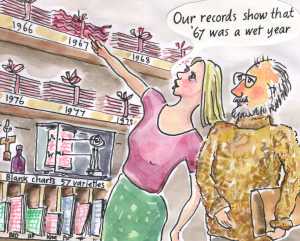
 |
Data loggers for climate measurement |
This article is divided into eight files which are intended to be read consecutively but if you want to hop around, here are the section titles:
The electronic age began, for preventive conservation, with a craze for putting data loggers in transport cases for fine art. This has subsided a bit, now that we know with scientific certainty to two decimals that high flying aircraft provide the safety of the womb and that the greatest risk to the art is that it will be trodden on as it awaits mounting in the panic before The Head of State opens the exhibition.
 After this glamorous start, electronic measurement of climatic and other quantities is now descending into mainstream museum life, still tinged with novelty but promising to release us from the purple finger syndrome that afflicts those who wind thermohygrographs.
After this glamorous start, electronic measurement of climatic and other quantities is now descending into mainstream museum life, still tinged with novelty but promising to release us from the purple finger syndrome that afflicts those who wind thermohygrographs.
The conservator's problem now is the bewildering diversity of choice in small loggers, many from small companies whose durability is uncertain. The durability of the particular model is very certain: it will be short. The generation interval of electronic gizmos is rivalling that of the fruit fly.
Changing over to electronic data gathering in a large museum is a very large investment in devices that may become unrepairable in a short time.
This is a disturbing contrast to the simplicity of the venerable hair and brass thermohygrograph, which could be understood, repaired and calibrated, after an hour of instruction that would remain up to date through a conservator's entire career.
In this article I will describe the types of electronic data logger, explaining the limitations that are not immediately apparent from the sales literature. Then I will describe the basic principles behind the sensors and how to deploy them to gather the most relevant and representative information.
This article is not a buyer's guide but rather a description of the technology, intended to help the reader choose the right equipment for her particular purpose. Where I mention names, they are of instruments I know, not necessarily the best.
There are some immediate advantages to electronic data gathering over the clockwork variety. The more advanced instruments can report a catastrophe as it unfolds instead of smugly recording the event as a jagged mountain top on the weekly chart, waiting patiently to be gathered in on its third circuit past the pen. Some data loggers can also actively intervene to close down or start equipment.
The data can be handled in a much more informative, and persuasive, way. It is easy to chain together data files to give a compact view of the year's weather. It is easy to insert in reports just the relevant portions of the data stream. Electronic data can be recalculated to give water vapour content, for example, from the measured temperature and RH. This is useful when you are searching for the source of unexpectedly extreme RH.
Data loggers are small and mechanically robust, with no preferred orientation, so that they can be enclosed with art in transit with negligible risk that they will break, or break loose.
Servicing the black box is more abstract than changing the paper and winding the clock on the thermohygrograph. Many conservators understandably have difficulty making the transition from direct mechanics to indirect key strokes. For routine surveillance the thermohygrograph has some advantages. In the broader context of preventive conservation the need to visit the thermohygrograph ensures that the room is inspected for other than climatic defects.

This work is licensed under a Creative Commons Attribution-Noncommercial-No Derivative Works 3.0 License.